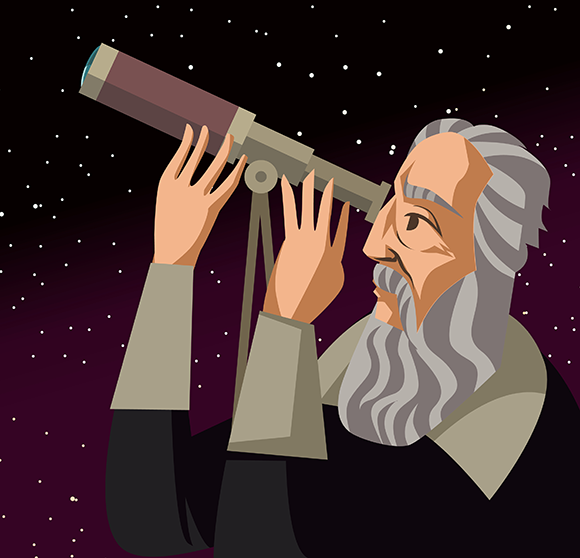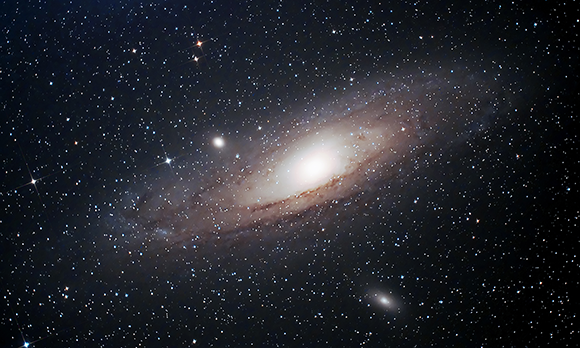Getting your Trinity Audio player ready...
In 1609, the Italian scientist Galileo Galilei came about the details of a new invention: a tube with two lenses that could be adjusted to vary the distance between them, enabling the observation of distant objects with magnification.
Read more:
Galileo, who was then at the University of Padua in northern Italy, began experimenting with the invention, understood the underlying physics, and effectively enhanced the device’s capabilities. His artistic talents complemented his scientific endeavors, quickly obtaining devices with the best magnification in the world. Shortly thereafter, the device also received its modern name "telescope," a compound word derived from the Greek words for “to see far.”
Galileo quickly recognized the commercial potential of his development: a good telescope could be used to see approaching military forces from a distance before they could detect the viewer, or it could be exploited for economic gain by providing early warning regarding merchant ships approaching the harbor. This realization helped him market his invention to his patrons, wealthy merchants, who also financed his research endeavors.
It’s always the sun
Galileo considered his research as his primary occupation, and in this field too he understood the great potential of the telescope. The observations he made during his early years as an astronomer helped change humanity’s perception of the world. For example, he discovered the major moons of the planet Jupiter, and the changing appearance of the planet Venus - two discoveries that helped finally disprove the notion that all celestial bodies revolve around the Earth. His findings illustrated the validity of the heliocentric model, with the Sun at the center, decades after the death of Copernicus, who was the first to publish an comprehensive scientific model of a system where planets, including Earth, orbit the Sun.
Galileo did not limit his observations to nighttime and also used his telescope to observe the Sun. He found that he could not see anything when observing it directly, but managed to discern details when observing it close to dusk, and especially if observing it through clouds or fog. He paid a high price for these observations, which possibly contributed to his blindness a few years prior to his death. However, he also made another revolutionary discovery: our sun is not a perfect sphere, as it was commonly thought since the days of Aristotle. It has imperfections, in the form of dark spots on its surface.
Galileo was not the first to notice sunspots: sporadic reports about them appear in ancient writings of Chinese, Greek and Arab scholars. Nevertheless, he was probably one of the first to observe them through a telescope and conduct a thorough survey of the Sun and its spots for many months. In 1613, he published his findings in a booklet named “History and Demonstrations Concerning Sunspots” (“Istoria e Dimostrazioni Intorno Alle Macchie Solari”), more commonly known as “Letters on Sunspots”, named so because it was based on a correspondence with the German scientist and Jesuit priest Cristoph Scheiner. Scheiner, like other pioneers, also observed sunspots at the time, but unlike Galileo he did not believe that the spots were part of the Sun - being a priest, he sought to preserve its integrity - and speculated that the spots were objects passing between us and the Sun, possibly natural satellites.
6 View gallery
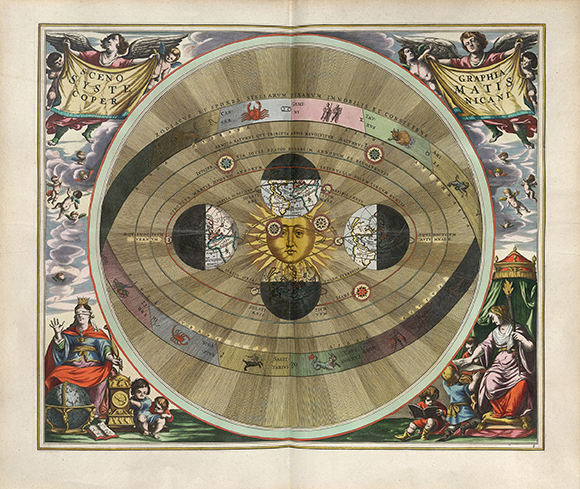

The heliocentric model used by Galileo and composed by cartographer Andreas Cellarius in 1660
(Photo: Wikimedia)
Galileo persisted with thorough observations, and also used a method developed by his pupil, Benedetto Castelli, to project the view obtained by the telescope onto another surface, enabling the study of the sun in full daylight without having to observe it directly. Galileo meticulously tracked certain sunspots during regular observations conducted at specific times, and observed how they gradually moved across the sun’s surface, eventually disappearing beyond its edge. Although he was uncertain about the nature of the sunspots, his observations convinced him that they either resided on the surface of the sun itself, or at most, consisted of clouds in its atmosphere. The implication of their movement across the sun was that, similar to the Earth, the sun was not an immobile sphere but also rotated around its axis.
In the subsequent years Galileo abandoned the study of sunspots in favor of other research, while Scheiner continued at it and became one of the leading experts in the study of sunspots in the first half of the 17th century. Eventually, Scheiner accepted Galileo's position, realizing that sunspots are indeed part of the Sun, and that the Sun also rotates on its axis. He summarized his findings in the book Rosa Ursina, published in 1630. In the book he presents evidence that the Sun rotates on its axis, and even estimates that the full rotation time to be about 27 Earth days - only slightly longer than the figure we know today: about 25 days and 9 hours.
Seeing Stars
The next conceptual leap was achieved by the French mathematician and philosopher Rene Decartes, who is considered one of the most important mathematicians in history. Descartes was not an astronomer and did not engage in research of the stars, but it was the philosophical aspect of his work that changed our perception of the world. In his 1644 book Principia Philosophiae (Principles of Philosophy), he presented an inaccurate model of the universe, composed according to him of ethereal matter with turbulence driving celestial bodies. However, he also proposed the concept that our Sun was not the center of the universe, but merely one among the countless stars that we see in the sky.
Less than a quarter of a century later, another Frenchman, the astronomer and mathematician Ismaël Bouillau (Bullialdus), proposed the idea that the periodic variations in the brightness of certain stars could be attributed to their self-rotation He suggested that these stars might possess a high concentration of sunspots or dark regions on one of their edges, and when this side faces us, we see a noticeable decrease in their brightness, compared to when their bright side faces us. While the explanation was scientifically incorrect, it did contribute to establishing a valid comparison between our Sun and other stars. Just like our sun, these celestial objects also undergo self-rotation.
Around the same time, the English physicist Issac Newton conducted groundbreaking experiments in optics and demonstrated using a dispersive prism that white light is composed of different colors. Today we know that each color represents a slightly different wavelength of electromagnetic radiation.
In the 19th century, scientists realized that the composition of wavelengths in light emitted by a source could reveal the composition of the materials producing that light. The new scientific field, spectroscopy, which means ‘observing the spectrum’, made it possible to discover what stars are made of, although later it became clear just how complex this task is.
Equally important for this matter is the ability to identify whether a star is moving, thanks to the Doppler Effect - a shift in the measured frequency of waves when an object approaches or moves away from the observer at speed (and also if the observer is the one approaching or moving away). In other words, if we know the spectral signature of a particular star, and which wavelengths it emits, we can see the exact same signature shifting towards the redder colors on the spectrum when the star moves away rapidly, referred to as “redshift” in professional jargon, or towards the blue colors when the star approaches us, referred to as “blueshift”.
In 1871, the German physicist Hermann Vogel demonstrated it is possible to measure the rotation speed of the Sun by measuring the redshift and blueshift near the edges of the star, as due to its rotation one edge is moving away from us at a high velocity, while its other edge is moving towards us at the same speed. It took a few more decades of refining measuring devices, until similar measurements made it possible to calculate the rotation speed of other stars, and to confirm Decartes’ assertion from 250 years earlier. Our sun is not special: the skies are filled with stars all of which rotate.
The hitchhiker’s guide to the galaxies
At the very end of the 19th century, a technological advancement emerged that allowed astronomers not only to observe stars but also to capture these observations on glass plates coated with photosensitive materials, effectively turning telescopes into cameras. This innovation enabled significantly more accurate measurements and gave rise to more precise spectroscopy, now referred to as spectrography, which essentially means "recording the spectrum."
The combination of large and more sophisticated telescopes and improved measurement techniques paved the way for the study of nebulae, celestial objects about which astronomers still held differing opinions regarding their nature.
One of the most studied nebulae in the early twentieth century was Andromeda, also known as M31. Already in 1899, the German astronomer Julius Scheiner discovered that Andromeda contains clusters of suns that are similar to our sun. Fifteen years later, two astronomers, Vesto Slipher from the United States and Max Wolf from Germany, succeeded in measuring, using spectroscopy, the movements of these stars across the nebula.
In 1917, another American astronomer, Francis Pease, managed to perform even more accurate measurements leaving no room for doubt: the stars in the Andromeda Nebula rotate around its center.
The questions regarding the true nature of nebulae remained unresolved and stood at the heart of the “Great Debate” of 1920 - a public and widely-publicized discussion between astronomers who were firmly convinced that nebulae were other galaxies, and their opponents who were certain beyond any doubt that the Milky Way constituted the entire universe, with the nebulae being distant objects at its outskirts.
The person who resolved this debate was the American astronomer Edwin Hubble, after whom the famous space telescope was named. Hubble utilized the discovery of the brilliant astronomer Henrietta Leavitt, which allowed the calculation of absolute distances to certain stars through measurements of their brightness.
Through measurements of such stars in Andromeda, Hubble calculated that its distance from us was approximately 900,000 light-years, far beyond the Milky Way, whose diameter was estimated at about 100,000 light-years (today we know that the distance to Andromeda is about 2.5 million light-years).
Consequently, it became evident that our Milky Way was merely one of hundreds of billions of galaxies, and the measurements conducted by Slipher, Pease and other researchers not only confirmed that stars rotate on their axes but also revealed that galaxies also exhibit this rotational motion.
Taking us for a spin
Galaxies spin on their axes, the stars that compose them rotate on their axes and around the center of their galaxy, planets rotate around stars and also orbit themselves, as we know thanks to the groundbreaking works of Copernicus, Kepler, Galileo and others. Moons orbit planets as well as spin on their axes, and even many of the smaller objects, such as comets and asteroids that orbit the Sun, rotate around on their axes. Our universe resembles one giant spinning top, made up of billions upon billions of spinning tops of varying sizes, all participating in a complex and magnificent cosmic dance. But why is it that nearly all celestial bodies rotate in the same direction?
The quest for an answer led scientists back in time, to its beginning. The Big Bang, the initial cosmic explosion during which the universe was formed, about 13.8 billion years ago, led to the formation of matter and its dispersion in all directions. But this dispersion was not uniform, causing more mass to accumulate in certain areas than in others. Gravity began to pull more matter into these mass-rich areas, and the giant clumps of matter became galaxy clusters, which gradually disintegrated into galaxies, constellations and individual stars with planets and moons.
The matter that was present in the young universe received its energy from the Big Bang, and some of it was transformed into the aforementioned spin, or in physical terms, provided it with angular momentum. A fundamental property of angular momentum is its preservation within a closed system, as long as no exterior force is applied to it.
Thus, those galaxy clusters and the galaxies that disintegrated from them conserved this angular momentum, and so did the stars that were formed in them, the planets, and the moons - all were formed from the same spinning matter and retained their angular momentum.
6 View gallery
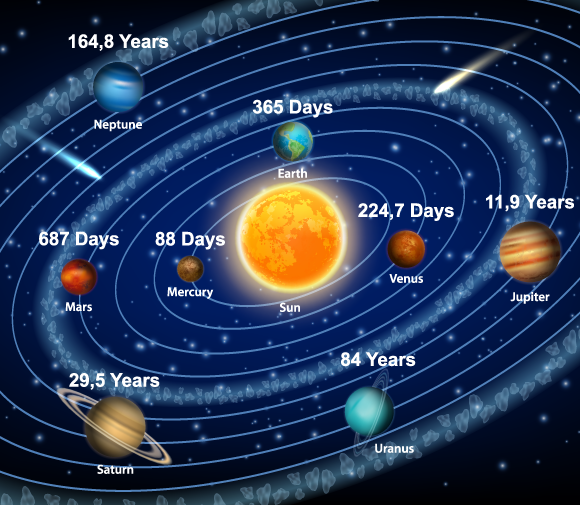

The solar system, roughly located on the same plane
(Photo: Siberian Art, Shutterstock)
This property is so fundamental in the universe that even dead stars continue to conserve their angular momentum. White dwarfs, neutron stars or black holes, for example, continue to rotate, even following cataclysmic events such as supernovae. In fact, as far as we know there is no object in the universe that is completely stationary. All objects are in motion relative to something, and this motion is almost always rotational.
Furthermore, the rotational movement of celestial bodies also dictates their shape. Almost all celestial bodies are spherical, as a result of a combination of two factors: the force of gravity acting on their mass and their own rotational motion. Sometimes it is the spinning that is responsible for the deviation from the perfect spherical shape. For instance, Earth’s diameter at the equator is 45 kilometers longer than the diameter measured between its poles, as the centrifugal force causes concentration of slightly more mass towards the direction of the rotation. Such distortions may be even more pronounced in non-solid bodies, such as stars or gaseous planets.
The shape of our solar system also stems from rotational movement. The Sun was formed from a cloud of gas and dust, as its rotational movement and gravity caused the remaining matter to arrange around it in a flat disk shape. From this disk, aggregates of matter that later formed the stars, were created during the rotational movement, with nearly all of them orbiting the Sun on the same plane.
In 1995, the first planet that orbits another sun was discovered, and since then we have discovered thousands more such planets, known as “exoplanets”, some of them in solar systems with many planets, and there too the planets are roughly aligned in a single plane. These same forces also dictate the shapes of galaxies. Many of them are flat, including our Milky Way, in which our Sun is just one of hundreds of billions of stars orbiting in a giant disk around the galactic center.
Deviating from the rules
We have previously stated that all of the planets of our sun orbit the Sun in the same plane, but the truth is that it's not entirely accurate. Seven out of the eight indeed are on the same plane, but the Planet Uranus deviates significantly from this plane. Furthermore, Uranus exhibits a very peculiar rotation - often described as spinning "sideways", with its equator perpendicular to its orbital plane and its rotational direction opposing that of other planets. How did this come to be?
The most likely explanation is a colossal collision. According to a study that is partially based on computer simulations, a celestial body at least twice the size of Earth forcefully collided with Uranus about 3-4 billion years ago, altering its course and dramatically changing the axis of its rotation. The origin of this impacting body remains speculative, perhaps it too was a product of a cosmic accident or the outcome of an explosion that ejected it from its original system and propelled it all into our vicinity.
Even in our small solar system, Uranus is not the only exception. Indeed planet Venus does orbit the Sun in its original orbit, but instead of spinning around its axis in the same direction as do the other planets, the direction of its spin is opposite. Its rotation time is also terribly slow.
6 View gallery
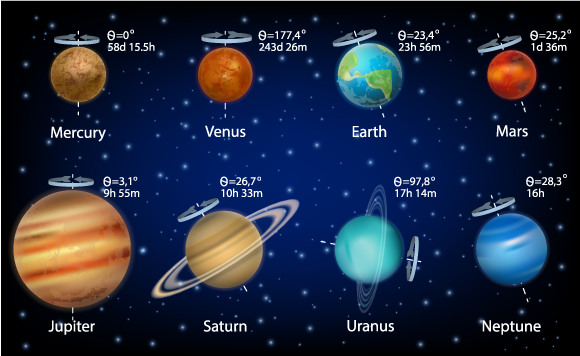

The angle of axis of each planet in the solar system
(Photo: Siberian Art, Shutterstock)
In fact, it completes a full rotation around its axis in such a long time that its day, lasting 243 Earth days, is longer than its year, which lasts only 224 Earth days. It can be said that on Venus every day is really a birthday. The common explanation for Venus’s peculiar spin is not a collision, but rather a restraining effect. According to the prevailing assumption - though the subject is far from unanimous agreement, the powerful drag forces exerted by Venus's highly thick atmosphere gradually slowed its spin to the point of reversing its direction.
The two largest planets in our solar system, Jupiter and Saturn, have dozens of moons, and their number undergoes updating from time to time, as researchers discover unknown moons. While the majority of these moons orbit their respective planets in the same direction, both Jupiter and Saturn have a few "rogue" moons that defy the norm by orbiting in the opposite direction.
In these cases too, researchers believe that the “rogue” moons are remnants of cosmic accidents - perhaps of moons that disintegrated in a collision with another moon, or another celestial body that entered their orbit.
Many of the moons of these two planets are relatively small, only a few kilometers in size, and some are even too small to take on a spherical shape. It is very possible that the smaller moons are products of collisions between moons or other bodies, and maybe some just passed near Jupiter at the right speed and were caught in its orbit due to its gravity. According to some theories, this is also the origin of the two tiny moons of Mars, Deimos and Phobos, which were asteroids or remnants of a collision between asteroids, before becoming caught in the gravity of our neighboring planet.
Another exception to the rules was identified in our solar system in 2017: an object several hundred meters long that passed here quickly and apparently left our solar system, so it does not orbit it, and as far as we know does not orbit any other star, although it rotates around itself vigorously in all three axes of rotation.
The object, which was named "Oumuamua," came, according to calculations of its velocity, from outside the Solar System and only briefly passed near us, leaving a long trail of theories regarding its origins: from a fraction of a disintegrating comet, through the remnants of a planet that was torn to pieces and even an alien ship that went out of control.
Assuming that it is in fact a natural object, and not the product of an advanced alien civilization, it does appear that it passed near us too fast to enter orbit around the Sun. Therefore, at the present moment, it does not orbit any star. Nevertheless, in the cosmic timeframe, the "moment" that seems eternal to us is but a fleeting instant. Oumuamua may eventually reach another solar system in a few thousand years, following a reduction in its velocity, and become bound to a new orbit.
Alternatively, it might continue its cosmic journey for millions of years, provided it avoids collisions with other objects or fragmentation, before it finds its orbit, unless it collides with something else by then, to be thrown into a new course or shatter completely.
Locking Time
Our large and beautiful Moon also exhibits a behavior that may initially seem perplexing. The Moon has a side that always faces us, towards Earth, and a far side - sometimes mistakenly called "the dark side" - that never faces us. Does this mean that the moon doesn’t rotate around its axis? Not necessarily, but it is in a state where the duration of its own rotation is identical to the duration of its orbit around the Earth - about 29 days.
This phenomenon is called Tidal Locking, or more precisely “synchronous orbit”, occurring due to tidal forces, or non-uniform distribution of mass in one of the celestial bodies. It is in fact quite common. Not only our moon is in tidal locking, but also the two moons of Mars that we have previously mentioned and more than a few of the moons of Jupiter and Saturn, moons of Uranus and Neptune, and also Charon, the largest moon of Pluto, which is no longer considered as a planet, but as a dwarf planet.
Not only moons can be in tidal locking, but also the planets themselves. Planet Mercury, the closest to the Sun, is in a type of tidal locking with it. Even if physically it is not a pure tidal lock but a state called “orbital resonance”, the result is that one side of Mercury always faces the Sun, and its other side is always facing away from it. The phenomenon is not limited to our solar system, and researchers believe for example that the interesting planet Proxima Centauri b, which was discovered a few years ago around our neighboring sun, is also in tidal lock with it.
Considering the numerous anomalies and exceptions to the conventional rules of rotation within our modest solar system, one can only guess the diverse array of celestial spinning tops scattered throughout the vast expanses of the Milky Way and other galaxies. Many phenomena remain beyond our current comprehension, such as the apparently excessive rotation speeds observed in certain galaxies, which might be attributable to what we now refer to as “dark matter.”
Nevertheless, the fascinating aspect is that all of these exceptions and phenomena, much like the fundamental laws of physics themselves, have scientific explanations - even if we haven’t unraveled them entirely, at least not yet. We can be sure that an explanation exists because, in the end, all celestial bodies, from the tiniest asteroid to the giant nebulae and galaxy clusters, abide by the same laws of physics. Galileo, with whom we started with, referred in his famous statement to the Earth itself, when he tried to disprove the notion that it is stationary and that everything revolves around it, but today we understand - in part thanks to him - that this principle applies universally to all celestial bodies: “And yet it moves.”


